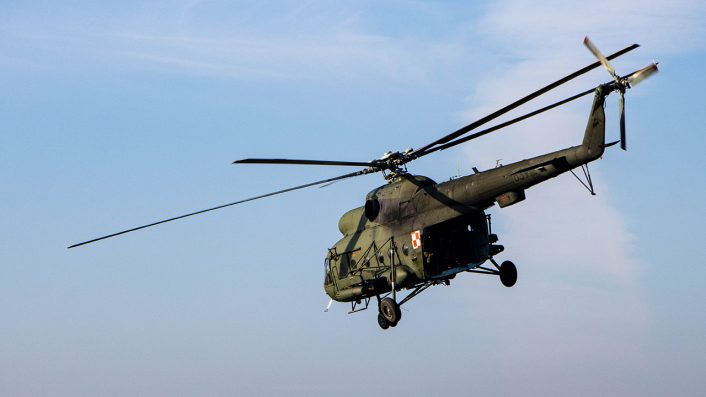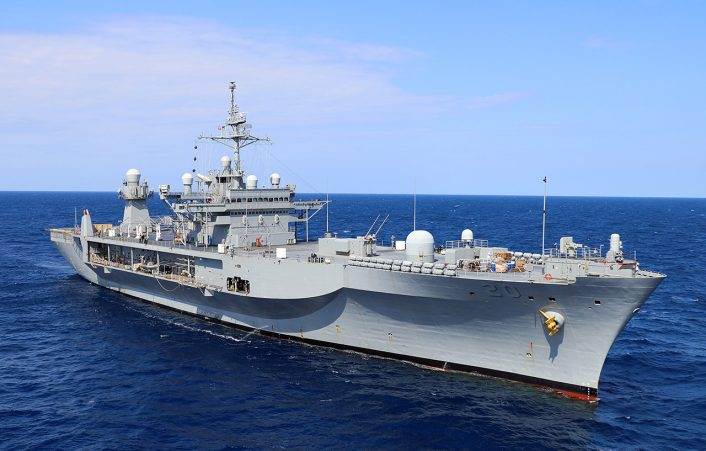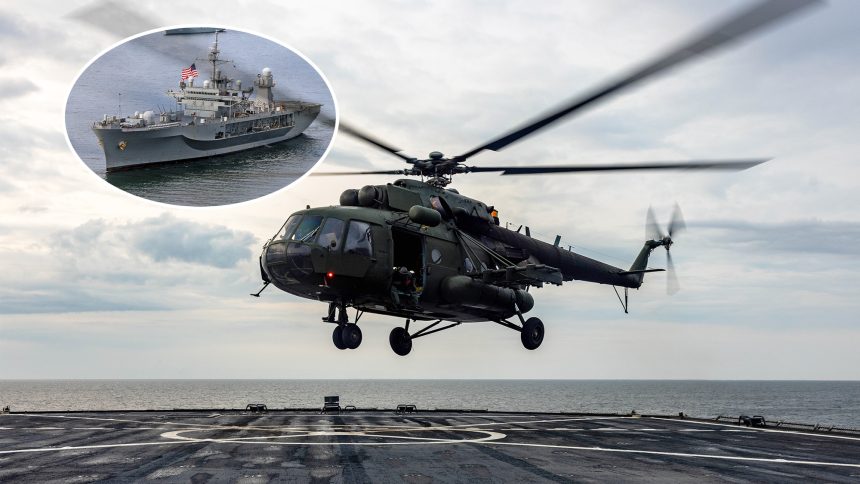The BALTOPS 25 exercise granted a rare sighting of a Soviet-designed helicopter landing on one of the U.S. Navy’s two Cold War era Blue Ridge class ships.
Sailing in the Baltic Sea, the USS Mount Whitney (LCC 20) offered its large aft helicopter deck as a facility for Polish military personnel operating the Soviet-designed Mil Mi-17 helicopter to practice and certify their deck landing skills. The Cold War era Blue Ridge class command and control ship Mount Whitney is operating as part of a large NATO flotilla taking part in the annual BALTOPS exercise, which began on Jun. 5, 2025.
🌊⚓Strength in Unity⚓🌊 A stunning display of naval power and partnership, as 40 ships from 16 nations join forces in the #BalticSea for the annual #BALTOPS exercise. These powerful images showcase #NATO’s military might, multinational cooperation & commitment to collective… pic.twitter.com/n5nv7zVGnr
— NATO Maritime Command (@NATO_MARCOM) June 6, 2025
BALTOPS 25 is a maritime-focused exercise comprising anti-surface warfare, anti-submarine warfare, mine countermeasures, air defense, and amphibious operations, among others. BALTOPS 24 was the largest instance of the exercise to date, and this year’s exercise sees participation from Belgium, Denmark, Estonia, Finland, France, Germany, Italy, Latvia, Lithuania, the Netherlands, Norway, Poland, Portugal, Sweden, the United Kingdom, and the United States.
Having completed the deck landing qualification, the Polish crew are now able to routinely operate their helicopters from U.S. Navy ships, increasing interoperability between the two NATO allies. According to the U.S. Navy, the Mi-17 was being operated by a special operations squadron, likely the Special Operations Aviation Unit based at the 33rd Air Base, Powidz.
“This Polish deck landing qualification aboard Mount Whitney is a testament to the outstanding teamwork and professionalism of both the Polish aircrew and our own Team 20,” said Captain Colin Price, USS Mount Whitney’s commanding officer. He added that “It’s through exercises like this that we build trust, enhance our interoperability, and strengthen our ability to operate seamlessly together to ensure security in the Baltic Sea region.”
The Mi-17 is the export variant of the Mil Mi-8, which began entering service with Soviet and Eastern Bloc forces in the mid-1970s. Much like comparable Western designs, like the Black Hawk and Puma, it has received a wide range of upgrades and continues to be produced by Russia to this day. Poland’s most recent deliveries of the type date from the early 2010s.

In the long term, these helicopters will likely be replaced by Western models, though the exact replacement plans are unclear. Reports in 2023 suggested that 22 AW101 helicopters would be ordered, to operate alongside those ordered for the Polish Navy, but no further news has become apparent regarding this procurement. More recently, it has been reported that Poland’s buy of the Sikorsky S-70i Black Hawk has been postponed.
Though Soviet-designed helicopters operating from U.S. ships is an uncommon and unusual sight, this is not the first time the Mount Whitney has received such a visit. Lithuanian Mi-8s have landed on board the ship on at least two occasions, and a Ukrainian Kamov Ka-27 visited in 2018. Perhaps most notably, in 2010, when relations with Russia were relatively normalized, the ship hosted ‘51 Red’, a Russian Navy Kamov Ka-27, during joint exercises.

The exercise was one of a number of NATO exercises in 2010 that saw a limited level of Russian participation, which provided near-unique views of Russian warships operating alongside ships that they had been designed to meet in battle. Today, the only similar images we can gather are of distant views of Russian or NATO vessels operating at a distance shadowing the others’ operations.

USS Mount Whitney
The newest of the two Blue Ridge class command and control ships which entered U.S. service in the early 1970s, the Mount Whitney is based in Gaeta, Italy, and serves as the flagship for the U.S. Navy Sixth Fleet. The ship spends much of its time operating in the Mediterranean, though occasionally ventures further afield across Europe to take part in exercises.

Its Mediterranean homeport makes it well positioned to assist in operations taking place in Africa and the Middle East. In 2023, Mount Whitney carried U.S. Sixth Fleet commander Vice Admiral Thomas Ishee and accompanying staff to the Eastern Mediterranean after the Oct. 7, 2023 Hamas attack against Israel.
Over 50 years old, the Blue Ridge class ships still rely on boilers and steam turbines for propulsion, and were based on the hull-form of the USS Iwo Jima (LPH 2) amphibious assault ship commissioned in 1961. The large deck area was put to use housing a plethora of antennas and other communications equipment. Many of these have today been replaced by modern equivalents, enabling advanced satellite communications to forces and commanders across the world.
Armament today comprises two Phalanx close-in weapons systems (CIWS) and two Mark 38 25mm machine gun systems. Previously, the ships carried RIM-7 Sea Sparrow box launchers along with four 3 inch cannons in two Mark 33 twin mounts. No hangar facilities are provided on board, but the ships routinely carry a MH-60S Sea Hawk helicopter for logistics support.

Mount Whitney’s sister ship, the USS Blue Ridge (LCC 19) is homeported in Yokosuka, Japan, and regularly sails across the Pacific region. It is expected to remain in service until 2039. Mount Whitney, meanwhile, is reportedly due to decommission in 2027. Placing this “indispensable” ship into retirement has been strongly criticized by former U.S. Navy officials, who argue that no other ship or base has the same capabilities. Unlike shoreside bases, the venerable command ship can be positioned wherever required and does not rely on the diplomatic approval of host nations for military operations.
Whether this retirement goes ahead will remain to be seen, as many such proposals from branches of the U.S. military often end up being overturned by Congress or by the Executive branch itself. A key case that demonstrates this was the 2015 proposal to close RAF Mildenhall by 2020, later reversed in the same year it was initially planned to shut down. Now, with intensified operations in the European theatre, the base has become even more important.









